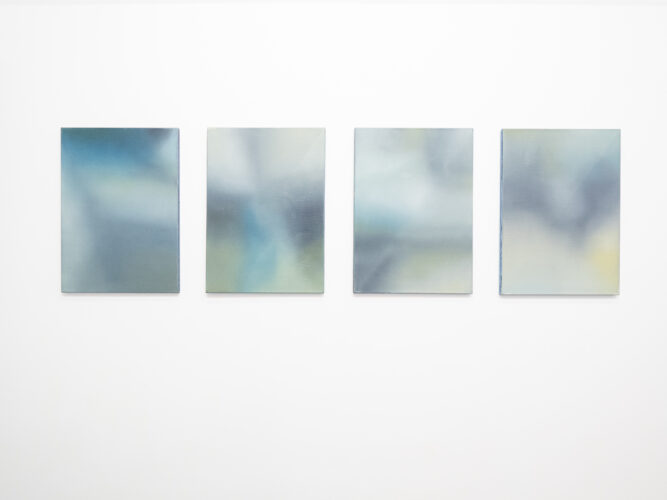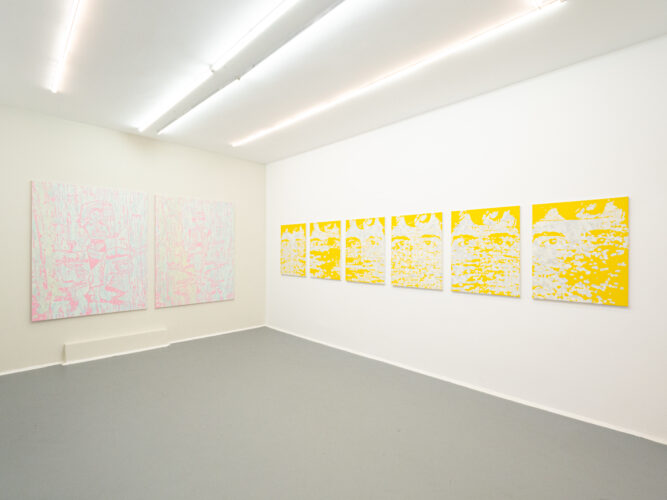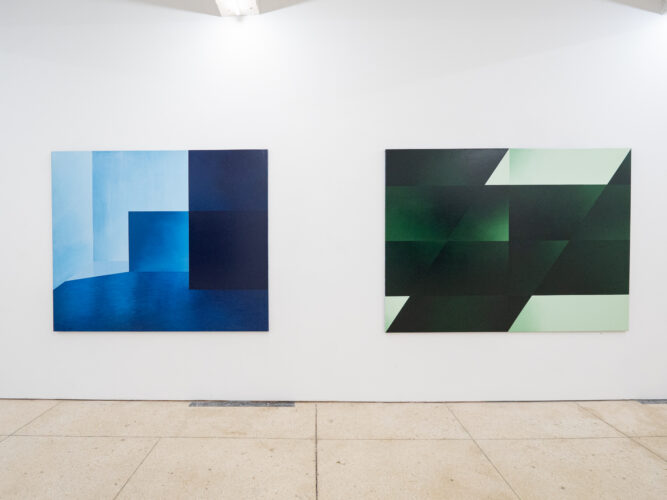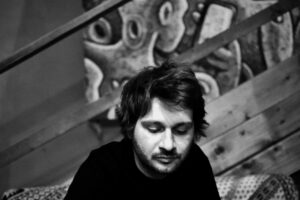We taxonomically belong to a group of species called bilateria, defined by a body structure that is essentially symmetrical between the left and right sides, which emerged as an adjustment to the natural world’s apparent indifference to mirror reflections. Our limbs and sense organs are arranged in symmetrical pairs, which in turn impose a high degree of symmetry on the brain.
From the distinction between the two sexes to the geography of individual anatomy, by splitting macroorganisms by a spine, we can speculate that we, conscious organisms, internalize this system, germinating it into the whole epistemological process. Thus, what could be the source of all value orderings with only two absolute poles? We notice this bias in ethical judgments such as good – bad; aesthetic: beautiful – ugly; ontological: everything – nothing, up to orderings in the political system and in the categorical subdivisions: left – right; abstract – figurative; color or monochrome. Moreover, the impending digital immateriality is also Boolean built between 1 and 0, true or false. If we look carefully, we can say that every action, object, process, environment, or judgment can be ordered within any chosen dichotomous system.
However, symmetry does not appear to be a default condition in the evolutionary vector but rather developed on an asymmetric molecular basis. At the micro-micro level, organisms are inherently asymmetric, suggesting that asymmetry comes first in biological evolution. DNA, the molecule that contains the genetic information that rules the development of any organism, is notoriously asymmetric. Starting from the study of the formation of matter, where, following cosmic radiation, the particle-negative parity of the matter was not preserved, it is worth pointing out that apart from the asymmetry of the weak nuclear interaction, the other three emerging force fields maintained the parity and, by speculation, we might as well have inhabited a mirrored world, unlike the real one.
This introductory and positivist digression lies in the fact that Gili Mocanu’s recently concluded exhibition is precisely dichotomous and, as I suspect, so is the entire conceptual scope of the artist’s body of work.
The works focus on a bipartite structure, both spatially and conceptually speaking, “Niciunul” / “No One” at Suprainfinit gallery and “Dumnezeu” / “God” at H’Art. As an opening statement, the premise of the exhibition can be found in the key distinguishing algorithm outlined by Ludwig Feuerbach in The Essence of Christianity: “In the beginning was the Word” (no one, in fact, the conceptual everything) and later, “All things were made through Him” (God).
“Religion is the disuniting of man from himself; he sets God before him as the antithesis of himself. God is not what man is – man is not what God is. God is the infinite, man the finite being; God is perfect, man imperfect; God eternal, man temporal; God almighty, man weak; God holy, man sinful. God and man are extremes: God is the absolutely positive, the sum of all realities; man the absolutely negative, comprehending all negations.”
What do the religious and artistic/auctorial systems have in common? They are both intersubjective systems, relationships, and content approvals of a large enough number of individuals that the artifacts, rituals, and spaces they propose, like monads made with the help of Pythia, become a new world.
The artifact catalog that Gili Mocanu has offered throughout his career leads me to describe him as a mere author rather than a visual artist. Gili Mocanu is among the very few players on the contemporary cultural scene who has left a decisive mark on several of his fields, such as: poetry, being included in the anthology edited by Marin Mincu and the one that gave birth to the poetic movement of the 2000s; music, through the soundscapes promoted in an avant-garde area, under the pseudonym Somnoroase Păsărele (Sleepy Birds); of course, the visual arts, which are discussed here. An author in the area of what is categorically called, as everything else today – mid-career – and, as is often the case with an artist of this name who shows steady progress and good institutional reputation, the works in the two spaces are, with few exceptions, not formal resolutions and new conceptual suggestions, but revisitation of well-defined older series, all coming from the creation of paintings on canvas.
Sequentially placed in conceptual as well as temporal order, similar to the cause-effect principle, the link between “No One” and “God” becomes all the more striking in the two exhibitions. In the first exhibition format, most of the works include geometric shapes with right angles, which refer to Platonic mathematical perfection. This is often seen by the opponents of the purely physical world as possible evidence of a god in the classic sense because of the precise constants of the relationship between the various phenomena of quantum or classical physics, and which, to an infinitesimal difference, would not have led to the creation of the universe, matter, or human consciousness as we know it. Some physicists point to a “hidden constant” that subtly but authoritatively sets the coordinates of the carbon empire. Mathematics, with its exact and cold perfection, thus appears as a process per se present in nature, and the individual is left only to discover its principles and thus understand Everything.
No One is the possibility of Everything, and in this case, the One becomes the prime monad – the absolute model and, at the same time, the absolutist opposite of the One, which is everything before it is even something.
Gili Mocanu often creates spatial or optical illusions on a flat surface, a recurring theme in the author’s work, whether we are talking about paintings with compositions in axonometric perspective or seen as through a pair of inverted binoculars; illusory chains placed directly on white walls; a false landing point for helicopters, drawn to scale in the ultra-compact center of Bucharest; poetry in the seemingly mundane triviality of sport; etc.
If the exhibition at Suprainfinit presents the matrix and the hidden structure as a contingent state (logos), the one in the H’Art gallery space is diametrically opposite and shows, through emergence, the organizing principle and the beginning of everything (logos spermatikos) – matter. This emphasis is also reinforced by the technique employed. The series presented are often made as impasto or apparent décollage in pictorial paste, as if the images are actually revealed to us by a creator from a total block with a common design.
The primordial couple becomes a pair of shepherds, represented how else – knowing the author’s fine irony – but under persistent rain. In turn, the lush palm-tree landscape of “Mamaia” is the typical avatar for the image of Eden, seemingly taken from the pictures of paroxysmal happiness in a Pentecostal children’s illustrated bible, but which are also the coordinates of the artist’s birthplace. The letters, or sounds in fact – C and O – become the skeleton on which the structured language is formed, which later becomes culture, and which eventually leads to swearing, but skillfully written in reverse, based on the technique of another character often associated with the avatar of the Creator, Leonardo. The most natural position to read the message is to sit backward, with a mirror in front of you, which in the attentive exhibition paneling is replaced by the artist’s eyes at the beginning of his career (27 years old), in Autoportret – Marea / Self-portrait – The Sea, revealed in succession and sinking. The corner of the house becomes the avatar of architecture, private property, and thus of the whole human material culture, which began with agrarian sedentism, but also symbolically represents the Christian trinity, the place where Russian icons and Suprematism works were hung and where the three lines met.
The unnamed works, which even an untitled would have demolished their metastable silence, naturally titled “–”, constructed with a subtle incised diagonal, which stems from the work Zet și nimic / Zed and Nothing (2012), where the last letter of the alphabet is paired with the nothing-void, as the absolute silence of the macro cosmos. Like the vector of matter, this flickering line is lost in a sea of light, as if polarized on the surface of an all-seeing lens – the uncreated light theorized by the Hesychasts. This series, as all the works in the second room, draws a direct sequential link with those in the Suprainfinit space.
Many of Gili Mocanu’s works seem to outline a vertical axis, sometimes visible, sometimes invisible, which, like the structure of organisms in the bilaterian class, mirrors the upside down, right to left. The author, born in Constanța, where he still spends summers, has long looked at the sea, with its horizontal line separating two seemingly uniform nothings – the sky and the sea. If we saw nothingness in a Frenhoferian way, in the macro fused form of these two spaces, we would be surprised later, looking into the section, to see that it is, in fact, atomized with the movement of the waves or cumulus clouds – small monads created seemingly out of nothing, just as particles come to life through observation and measurement, emerging as indivisible points from total, contingent fields.
As the artist’s ubiquitous gallerist, Dan Popescu, whose philosophy thesis is written on Lucian Blaga’s Teoria Cunoașterii / Theory of Knowledge, explained to me during a tour of the exhibition, there are vital authors in every culture who, in everything they do or wherever they go, instill a spirit of the place they come from. Thus, any new artifact becomes a possible heterotopia, similar to the exile in the same harbor, unveiled in Dumnezeu s-a născut în exil / God Was Born in Exile.
The exhibitions No One/God by Gili Mocanu took place during 12.10 – 8.11.2022 at Suprainfinit gallery and 19.10 – 31.12.2022 at H’Art gallery.
Translated by Camelia Diaconu
POSTED BY
Horațiu Lipot
Horațiu Lipot (b. 1989, Alba Iulia) is a curator and cultural journalist. As of 2021, he works as an independent curator, collaborating with venues either from the ON or OFF art- scene in Bucharest, ...





Comments are closed here.